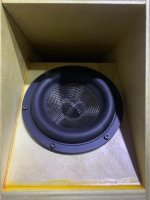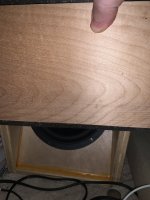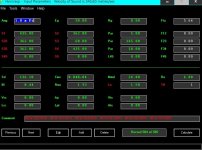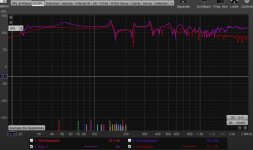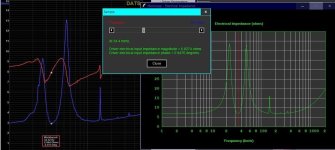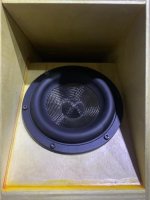Here is a prime example.
28hz T-TQWT = 8ft horn, 317L, & 625wrms.
27hz TH = 11ft horn, 434L, & 650wrms.
All I did was flip the throat and mouth for simplicity.
Hofmann's Iron Law.










28hz T-TQWT = 8ft horn, 317L, & 625wrms.
27hz TH = 11ft horn, 434L, & 650wrms.
All I did was flip the throat and mouth for simplicity.
Hofmann's Iron Law.
I meant the area directly in front of the driver is covered with wood instead of being exposed to the room fully?
we Both use tapered qw pipes, but you clog up your exit Unnecessarily(?) and I dont Understand why (after listening to and measuring the difference)
we Both use tapered qw pipes, but you clog up your exit Unnecessarily(?) and I dont Understand why (after listening to and measuring the difference)
Attachments
Last edited:
What a great comparison! The expanding path shape filled in the saddle/saggy response shape so much better 😱Here is a prime example.
28hz T-TQWT = 8ft horn, 317L, & 625wrms.
27hz TH = 11ft horn, 434L, & 650wrms.
All I did was flip the throat and mouth for simplicity.
Hofmann's Iron Law.
View attachment 1360790View attachment 1360794
View attachment 1360792View attachment 1360795
View attachment 1360801View attachment 1360802
View attachment 1360803View attachment 1360805
View attachment 1360807View attachment 1360809
because the second resonace is quite a bit closer to the fundametal in those maybe? Or the driver is in a bit more pressure between the resonances from the skinny CSA @ start?
I meant the area directly in front of the driver is covered with wood instead of being exposed to the room fully?
we Both use tapered qw pipes, but you clog up your exit Unnecessarily(?) and I dont Understand why (after listening to and measuring the difference)
It's a BANDPASS enclosure, i. e. buried driver enclosure.
TH = BP6S where the WHOLE enclosure is a negative, straight, or positive flare port.
NORMAL BP6 (series or parallel) enclosures DO NOT have ports with the CSA of Sd.
A simple straight flare single fold TH can be modeled with either the TH or BP6S function in HR.
All folded qw length shapes cancel out at the full wavelegth between the driver locations it seems. Everything ‘1/4 wave’ is ‘bandpass’ regardless?
Last edited:
Technically, TL's are not BP's since the driver is mounted on the exterior of the enclosure.All folded QW length shapes cancel out at the full wavelength between the driver locations it seems. Everything ‘1/4 wave’ is ‘bandpass’ regardless?
I like BP's due to no need for grills for driver protection and lower distortion.
External driver mounting = mechanical noise.
What a great comparison! The expanding path shape filled in the saddle/saggy response shape so much better 😱
because the second resonance is quite a bit closer to the fundamental in those maybe? Or the driver is in a bit more pressure between the resonances from the skinny CSA @ start?
Thanks guy!
You'll have to ask DMB and Tom Danley those 2 questions. I'm just a basshead modeler.
I meant the area directly in front of the driver is covered with wood instead of being exposed to the room fully?
we Both use tapered QW pipes, but you clog up your exit Unnecessarily(?) and I don't Understand why (after listening to and measuring the difference)
The beauty of the TH, I can change the exit and the performance don't change.
I prefer MTH alternate for ease of build, driver mounting, and standing up the driver.
You can do MTH, but you might have to deal with cone sag unless lay the enclosure on its side.
Tom Danley's THSPUD provides the side exit option.
Is this a ‘bandpass’? It starts canceling out once the frequency approaches the full wavelegth of the distance between the driver entry and the vent (and other side of the driver)Technically, TL's are not BP's since the driver is mounted on the exterior of the enclosure.
I like BP's due to no need for grills for driver protection and lower distortion.
External driver mounting = mechanical noise.
Attachments
If I didn't care about physics, then I would use plain old sealed enclosures for ALL my audio.
Peaks and U's are PHYSICAL things.
You just don't like that I simplify complicated things.
Is it true that a sealed enclosure has a single peak or no U's in its impedance measurement?
Is it true that BR and BP4 enclosures have 2 peaks or 1 U in its impedance measurements?
Is it true that a BP6 enclosure has 3 peaks or 2 U's in its impedance measurement?
If the answer to those 3 questions are yes, then without PHYSICALLY seeing the enclosures, you can NAME the enclosure type...4th order, 6th order, etc.
The only stipulation to those statements is BR's and BP4's have the same type of impedance graph. You would then need to see the PHYSICAL enclosure.
Same situation with DBR's and BP6's.

Peaks and U's are PHYSICAL things.
You just don't like that I simplify complicated things.
Is it true that a sealed enclosure has a single peak or no U's in its impedance measurement?
Is it true that BR and BP4 enclosures have 2 peaks or 1 U in its impedance measurements?
Is it true that a BP6 enclosure has 3 peaks or 2 U's in its impedance measurement?
If the answer to those 3 questions are yes, then without PHYSICALLY seeing the enclosures, you can NAME the enclosure type...4th order, 6th order, etc.
The only stipulation to those statements is BR's and BP4's have the same type of impedance graph. You would then need to see the PHYSICAL enclosure.
Same situation with DBR's and BP6's.
- Home
- Loudspeakers
- Subwoofers
- 18sound 21LW1400 enclosure
